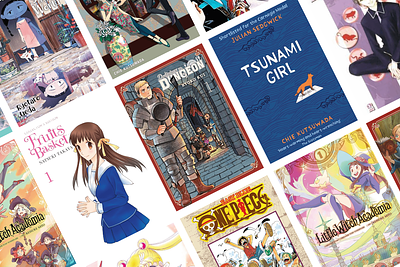What is manga?
Originating in Japan, manga are comics or graphic novels often sold as volumes as part of a longer series. Manga has become more and more popular with young readers in the last few years, with 1.8 million manga titles sold across the UK(this link will open in a new window) in 2022 – over double the sales in 2019.
The rise of manga has gone hand in hand with the rise of anime. Anime refers to Japanese animations or cartoons which are often, but not always, adapted from manga comics. In 2021, Netflix stated that half of its users had watched anime(this link will open in a new window). For anime fans, manga can provide an expanded version of the story, world or characters they’ve enjoyed watching – meaning some children who may not consider themselves to be 'readers' might try manga!
Benefits of reading manga
Though manga is a format and not a genre, manga titles are united by some conventions. These include the fact that manga books, and pages within them, are read from right to left (see Walker Books guide to reading manga(this link will open in a new window)). Throughout the text, readers will also often find onomatopoeias(this link will open in a new window) – Japanese characters that represent the sounds of the story – or character marks like the ikari maaku(this link will open in a new window). Elements like this help develop cultural understanding in its readers. Manga is full of information about Japanese language, history, traditions, culture and society. Through reading manga, readers can connect to another culture and another way of life.
Like graphic novels and comics, manga is primarily told through images. This makes them "multimodal texts" (this link will open in a new window)– meaning readers have more than one way of understanding the text and story. Multimodal texts develop visual literacy as the reader must decode the meaning or symbolism of the images and connect them to the words. This is particularly engaging for children who find reading difficult, or have dyslexia or visual stress, as the images provide additional context.
Many children who read manga may go on to read other forms of books, for example, non-fiction books about Japan or Japanese history, fiction books set in Japan, or novelised adaptations of their favourite anime. However, even if they only want to read manga, they’re still reading and, more importantly, reading for pleasure, the benefits of which include better literacy skills and vocabulary as well as better social skills and empathy and better mental health(this link will open in a new window).
How to find manga titles
If you’re not sure how to find manga titles suitable for your children, or the children you work with, a great place to start is chatting to your local librarian or bookseller.
Start with the animes or genres the children are already interested in. If they have a favourite anime, see if there’s an original or tie-in manga. If they like a particular genre of books or films, look for that genre in manga.
For younger readers, we love the surreal magical realism of Hana-chan and the Shape of the World by Ryotaro Ueda. Little Witch Academia, is also a great introduction to manga: featuring a young witch who enrols at her dream magic school. Readers might enjoy comparing differences between the manga and the anime! For fans of J-Pop or K-Pop, Hikaru in the Light! by Mai Matsuda is a fun story about a young girl who dreams of being a pop idol.
For older readers, Delicious in Dungeon takes place in a world similar to Dungeons and Dragons role-playing games and follows Laios Touden as he fights (and cooks!) his way through different dungeons. Fruits Basket is a classic, following a young girl who befriends her classmate and must uncover the secret of his family curse.
If you’re worried about age or content, some manga books will also have age ratings directly on the books. You can also use the publisher’s websites to find out their ratings and what they mean – see VIZ Media’s example of age ratings and descriptions(this link will open in a new window). You can also look into accessing titles online. Some publishers offer discounted rates for reading manga through their apps. This allows readers to read on their phones or tablets.
However you read manga – we hope you enjoy it. If you want to create your own, make sure you check out our resource from manga artist Chie Kutsuwada. If you’ve enjoyed this article, you may like to read the others we’ve written on different formats of reading, including magazines and comics, gamebooks and audiobooks.

